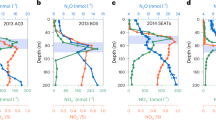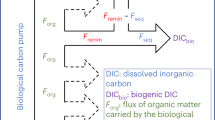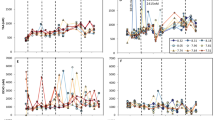Abstract
THE processes that regulate the cycling of oceanic dissolved organic carbon (DOC), one of the largest carbon reservoirs on the Earth's surface1, are largely unknown. DOC residues in the deep sea, below 500 m, seem to be composed mainly of biologically refractory compounds2–10 such as humic substances11. The average apparent 14C age of this refractory DOC is >6,000 yr in the deep Pacific2, suggesting that its rate of turnover is slow, but the pathways and rates responsible for this apparent slow turnover are unknown. Several studies have shown that aquatic humic substances are photochemically degraded by sunlight into biologically labile and/or volatile organic compounds12–14 and carbon monoxide15,16. Here we present new data which suggest that this photochemical degradation pathway is the rate-limiting step for the removal of a large fraction of oceanic DOC. This rate will increase with increasing flux of solar ultraviolet-B radiation. We estimate the oceanic residence time of biologically refractory, photochemically reactive DOC to be 500–2,100 yr, which is less than its average apparent 14C age. The injection of 'old carbon' from sediments into the deep sea may explain this discrepancy.
This is a preview of subscription content, access via your institution
Access options
Subscribe to this journal
Receive 51 print issues and online access
$199.00 per year
only $3.90 per issue
Buy this article
- Purchase on Springer Link
- Instant access to full article PDF
Prices may be subject to local taxes which are calculated during checkout
Similar content being viewed by others
References
Mopper, K. & Degens, E. T. in The Global Carbon Cycle (eds Bolin, B., Degens, E. T., Kempe, S. & Ketner, P.) 293–316 (Wiley, New York, 1979).
Williams, P. M. & Druffel, E. R. M. Nature 330, 246–248 (1987).
Menzel, D. W. & Ryther, J. H. Deep-Sea Res. 15, 327–337 (1968).
Barber, R. T. Nature 220, 274–275 (1968).
Craig, H. J. Geophys. Res. 76, 5078–5086 (1971).
Williams, P. M. & Carlucci, A. F. Nature 262, 810–811 (1976).
Toggweiler, J. R. Nature 334, 468 (1988).
Williams, P. M. & Druffel, E. R. M. Oceanography 1, 14–17 (1988).
Toggweiler, J. R. in Productivity of the Ocean: Present and Past (eds Berger, W. H., Smetecek, V. S. & Wefer, G.) 65–83 (Wiley, New York, 1989).
Druffel, E. R. M., Williams, P. M. & Suzuki, Y. Geophys. Res. Lett. 16, 991–994 (1989).
Malcolm, R. L. Analyt. Chim. Acta 232, 19–30 (1990).
Kieber, D. J., McDaniel, J. & Mopper, K. Nature 341, 637–639 (1989).
Geller, A. Limnol. Oceanogr. 31, 755–764 (1986).
Kieber, R. J., Zhou, X. & Mopper, K. Limnol. Oceanogr. 35, 1503–1515 (1990).
Redden, G. D. thesis, Oregon State Univ. (1983).
Valentine, R. L. & Zepp, R. G. EOS 71, 1236 (1990); Abstr. 201st National Meeting Am. chem. Soc. Div. Envir. Chem. 524–527 (American Chemical Society, 1991).
Sugimura, Y. & Suzuki, Y. Mar. Chem. 24, 105–131 (1988).
Suzuki, Y. & Tanoue, E. in Ocean Margin Processes in Global Change (eds Mantoura, R. F. C., Martin, J. M. & Wollast, R.) 18–23 (Dahlem Workshop, Wiley, Berlin, 1991).
Koike, I., Hara, S., Terauchi, K. & Kogure, K. Nature 345, 242–244 (1990).
Toggweiler, J. R. Nature 345, 203–204 (1990).
Mopper, K. & Zhou, X. Science 250, 661–664 (1990).
Zafiriou, O. C., Joussot-Dubien, J., Zepp, R. G. & Zika, R. G. Envir. Sci. Techn. 18, 358A–371A (1984).
Kieber, R. J. & Mopper, K. Envir. Sci. Technol. 24, 1477–1481 (1990).
Mopper, K. & Stahovec, W. L. Mar. Chem. 19, 305–321 (1986).
Kieber, D. J. & Mopper, K. Mar. Chem. 21, 135–149 (1987).
Butler, J. H., Pequegnat, J. E., Gordon, L. I. & Jones, R. D. Estuar. Coast. Shelf Sci. 27, 181–203 (1983).
Jones, R. D. Deep-Sea Res. 38, 625–635 (1991).
De Haan, H. & De Boer, T. Water Res. 21, 731–734 (1987); Stewart, A. J. & Wetzel, R. G. Limnol. Oceanogr. 25, 559–564 (1980).
Chen, R. F. & Bada, J. L. Geophys. Res. Lett. 16, 687–690 (1989).
Blough, N. V. & Zepp, R. G. (eds) Effects of Solar Ultraviolet Radiation of Biogeochemical Dynamics in Aquatic Environments (Woods Hole Oceanographic Institution Techn. Rep. 90–09, Massachusetts, 1990).
Kouassi, A. M., Zika, R. G. & Plane, J. M. C. Neth. J. Sea Res. 27, 33–41 (1990).
Baker, K. S., Smith, R. C. & Green, A. E. S. in The Role of Solar Ultraviolet Radiation in Marine Ecosystems (ed. Calkins, J.) 79–91 (Plenum, New York. 1982).
Zafiriou, O. C. & True, M. B. Mar. Chem. 8, 33–42 (1979).
Dahlback, A., Henriksen, T., Larsen, S. H. H. & Stamnes, K. Photochem. Photobiol. 49, 621 (1989).
Cutchis, P. Science 184, 13–19 (1974).
Zepp, R. G., Hoigné, J. & Bader, H. Envir. Sci. Technol. 21, 443–450 (1987).
Zepp, R. G. & Cline, D. M. Envir. Sci. Technol. 11, 359–366 (1977).
Spinhirne, J. D. & Green, A. E. S. Atmos. Envir. 12, 2449–2454 (1978).
Smith, R. C. & Baker, K. S. Oceanography 2, 4–10 (1989).
Stamnes, K., Slusser, J., Bowen, M., Booth, C. & Lucas, T. Geophys. Res. Lett. 17, 2181–2184 (1990).
Broecker, W. S. & Peng, T.-H. Tracers in the Sea (Eldigo, New York, 1982).
Stuiver, M., Quay, P. D. & Ostlund, H. G. Science 219, 849–854 (1983).
Mathews, R. W. Radiat. Res. 83, 27–41 (1980).
Wang, W. H., Beyerle-Pfnür, R. & Lay, J. P. Chemosphere 17, 1197–1204 (1988).
Williams, P. M., Carlucci, A. F. & Olson, R. Oceanol. Acta 3, 471–476 (1980).
Starikova, N. D. Oceanol. 10, 796–807 (1970).
Devol, A. H. & Ahmed, S. I. Nature 291, 407–408 (1981).
Mopper, K. in Proc. MarChem'91 Workshop (Office of Naval Research, Steamboat Springs, Colorado, 1991).
Mopper, K. & Park, Y. C. in Background Papers Workshop on Measurement of Dissolved Organic Carbon and Nitrogen in Natural Waters (NSF/NOAA/DOE, Seattle, 1991).
Meyers-Schulte, K. J. & Hedges, J. I. Nature 321, 61–63 (1986).
Hedges, J. I. Mar. Chem. (in the press).
Author information
Authors and Affiliations
Rights and permissions
About this article
Cite this article
Mopper, K., Zhou, X., Kieber, R. et al. Photochemical degradation of dissolved organic carbon and its impact on the oceanic carbon cycle. Nature 353, 60–62 (1991). https://doi.org/10.1038/353060a0
Received:
Accepted:
Issue Date:
DOI: https://doi.org/10.1038/353060a0
This article is cited by
-
High concentrations of dissolved biogenic methane associated with cyanobacterial blooms in East African lake surface water
Communications Biology (2021)
-
Enigmatic persistence of dissolved organic matter in the ocean
Nature Reviews Earth & Environment (2021)
-
Societal importance of Antarctic negative feedbacks on climate change: blue carbon gains from sea ice, ice shelf and glacier losses
The Science of Nature (2021)
-
Export of photolabile and photoprimable dissolved organic carbon from the Connecticut River
Aquatic Sciences (2021)
-
Removal of Refractory Dissolved Organic Carbon in the Amundsen Sea, Antarctica
Scientific Reports (2020)
Comments
By submitting a comment you agree to abide by our Terms and Community Guidelines. If you find something abusive or that does not comply with our terms or guidelines please flag it as inappropriate.



